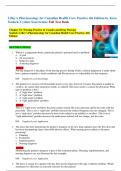Exam (elaborations)
Lilley's Pharmacology for Canadian Health Care Practice 4th Edition by Kara Sealock, Cydnee Seneviratne Test Bank
- Course
- Institution
- Book
Discover the Test Bank, a valuable resource packed with study questions designed to assist your exam preparation. Upon checkout, enjoy quick and instant downloads—no waiting required. Harness the power of test banks to elevate your study sessions and enhance your academic performance.
[Show more]




